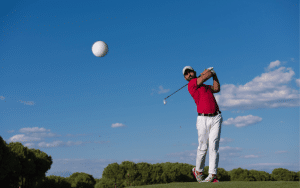Introduction
Welcome to our comprehensive guide on understanding and controlling golf ball flight.
In this article, we'll delve into the factors that affect ball flight, the techniques for controlling it, and the various factors that impact ball flight control.
Whether you're a beginner or a seasoned golfer, mastering the art of controlling ball flight is crucial for improving your game.
Let's explore the tips, strategies, and insights that will help you gain better control over your golf ball's trajectory and direction.

Understanding Golf Ball Flight
Several key factors influence the flight of a golf ball. One of the primary factors is the angle of the clubface at impact.
The clubface's angle determines the initial direction of the ball, making it vital for achieving the desired trajectory.
Moreover, the ball's spin plays a significant role in its flight. Backspin creates lift, resulting in a higher ball flight, while sidespin affects the ball's curvature.
Additionally, the speed of the swing directly impacts the ball's velocity and trajectory, making it a critical factor in controlling ball flight.
Understanding the different types of ball flights is essential for honing your control skills.
The three primary ball flights are the draw, fade, and straight flight.
A draw occurs when the ball starts right of the target and curves back to the left, beneficial for navigating around obstacles.
Conversely, a fade begins left of the target and curves right, providing a useful trajectory for certain course layouts.
Mastering these flight types allows you to adapt to varying course conditions and effectively navigate challenging terrains.
- Draw: The draw is a ball flight that starts right of the target and then bends or curves back to the left. It provides golfers with the advantage of navigating around obstacles on the course, allowing for a wider margin of error.
- Fade: The fade is a ball flight that begins left of the target and then curves or bends to the right. This type of shot can be beneficial for navigating certain course layouts and avoiding trouble spots.
- Straight Flight: A straight flight is the most accurate ball flight, traveling directly towards the target without any significant deviation. It is essential for precision and control, particularly in challenging course conditions.
Techniques for Controlling Ball Flight
The grip and hand positioning are fundamental elements in controlling the ball flight.
Adjusting the grip pressure can influence the clubface angle at impact, thus affecting the direction and trajectory of the ball.
Furthermore, the positioning of the hands on the club plays a pivotal role in imparting spin to the ball, thereby enabling you to shape your shots according to the desired flight path.
- Proper Grip: The way you hold the club has a significant impact on the outcome of your shots. A stronger or weaker grip can influence the clubface angle at impact, affecting the ball's trajectory.
- Grip Pressure: Understanding how to adjust grip pressure is crucial for controlling the clubface angle and, ultimately, the ball flight. It's essential to find a balance in grip pressure to achieve optimal results.
- Hand Positioning: The placement of your hands on the club determines how much spin you can impart on the ball. By adjusting hand positioning, you can manipulate the spin and shape of your shots.
Implementing specific adjustments in your swing technique allows for greater control over the ball's flight.
Focusing on tempo, rhythm, and swing plane can enhance the consistency and accuracy of your shots.
Additionally, mastering the release and follow-through of the swing contributes to achieving the intended ball flight, making it essential to refine these aspects of your swing.
Engaging in targeted shot-shaping drills is an effective way to develop precise control over the ball's flight.
These drills involve intentionally shaping the trajectory of your shots to achieve specific flight patterns.
By practicing draw and fade shots, you can refine your ability to adapt to varying course conditions and navigate through challenging terrain with confidence.
Factors Impacting Ball Flight Control
When it comes to golf, the course conditions play a pivotal role in influencing ball flight control.
Taking into account various environmental factors such as wind speed, terrain elevation, humidity, and temperature is essential for optimizing your performance.
Let's delve into the specifics of how each of these factors affects your game:
- Wind Speed: The direction and strength of the wind can significantly alter the trajectory and distance of your shots. Headwinds, crosswinds, and tailwinds each require a unique approach to maintain control over the ball's path.
- Terrain Elevation: Uphill and downhill lies can affect club selection and the angle of attack, impacting the launch angle and overall distance of the shot.
- Moisture Levels: The moisture content of the grass and soil can influence the spin and roll of the ball, affecting its final position on the fairway or green.
Adapting your strategy to account for these conditions is key to achieving the desired ball trajectory and direction.
Being aware of how environmental factors come into play enables informed decision-making, enhancing not only your shot selection but also your overall performance on the course.
Equipment Considerations
The equipment you use plays a vital role in determining and controlling ball flight.
Factors such as club selection, ball type, and shaft characteristics directly influence the behavior of the golf ball in flight.
Additionally, optimizing your equipment setup according to your swing style and playing preferences can lead to improved consistency and accuracy in controlling ball flight.
Conclusion
Mastering the art of controlling golf ball flight is a continuous journey that demands patience, practice, and a deep understanding of the numerous factors at play.
By honing your technique, adapting to course conditions, and leveraging the right equipment, you can elevate your game and achieve greater precision and consistency in your shots.
Remember, continuous learning and application of effective strategies are key to unlocking your full potential in mastering the complex yet rewarding skill of controlling golf ball flight.
